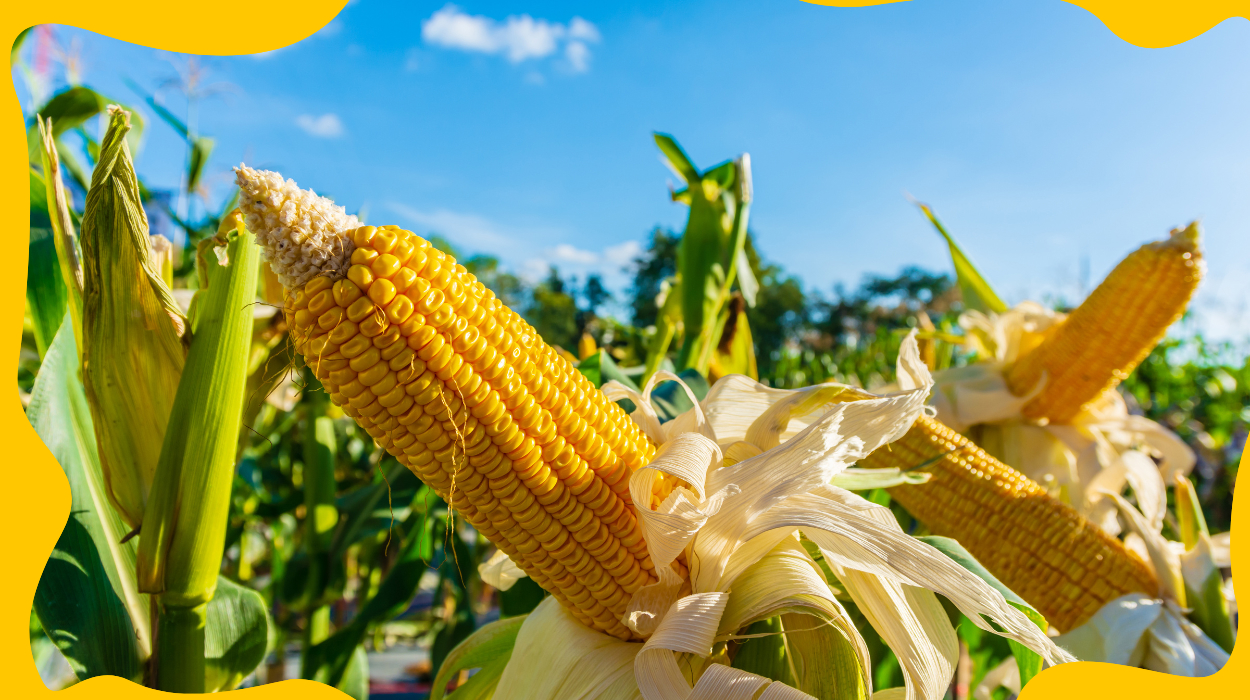Is Corn Good For Diabetes? Here’s What Experts Say In 2024

With summer on the horizon, most of us are already dreaming of poolside barbecues and the delicious aroma of homemade burgers and grilled corn on the cob. However, if you live with diabetes, this cheerful occasion may also be a time to consider, is corn good for those with diabetes? While we all want to enjoy the summer festivities, this must include a balanced and healthy diet.
Around this time of year, many people with diabetes wonder, does corn raise blood sugar? Is corn bad for diabetes, or can it help keep my glucose levels steady? Like everything else in life, the answer is not a simple yes or no. Yes, fresh corn is good for peope with diabetes,[1] in moderation, but eating it in excess can also contribute to blood sugar spikes. Here’s everything you need to know about corn and diabetes.
Is Corn Good For Diabetes?
Yes, corn can be beneficial for those with diabetes because it contains fiber that can help regulate blood sugar spikes. It is also low in the glycemic index, so it does not tend to cause blood glucose levels to spike as with other starchy vegetables. Since such spikes are concerning and even dangerous for those with diabetes, this makes corn in moderation part of a good strategy.
Corn Nutrition Facts
Scientifically known as maize, corn has its roots deeply embedded in ancient American culture. With its bright-yellow, juicy kernels that sometimes come in multicolored varieties, corn as we know it today has never existed in the wild. The domestication of corn is believed to have originated in Mesoamerica, where ancient civilizations revered it as a sacred crop symbolizing sustenance and fertility.
Early corn, known as teosinte, looked and tasted different from the corn of today. Teosinte kernels were small and surrounded by a tough outer layer. Indigenous people used selection and cultivation to transform teosinte into the larger, juicier varieties of today.
Today’s corn is likely sweeter and possibly less dense than ancient corn but still packs a mighty nutritional punch. One medium ear[2] of sweet corn contains:
- 87.7 calories.
- 19 grams of carbohydrates.
- 2 grams of dietary fiber.
- 6 grams of sugar.
- 3 grams of protein.
- 1.38 grams of fat.
- Vitamin A — 191 International Units.
- Vitamin C — 7 milligrams.
- Sodium — 15.3 milligrams.
- Potassium — 275 milligrams.
- And magnesium, iron, and zinc.
Is Corn High In Sugar? Can People With Diabetes Eat Corn?
Corn does contain naturally occurring sugars. However, it is also high in several nutrients and not harmful to your health if you are living with type 1 or 2 diabetes. How food affects blood sugar, is measured by its glycemic index. Foods with a GI below 55 are considered low; 56-69, medium; and foods high in refined carbohydrates — e.g., processed sweets, white bread, etc. — with a GI score of 70 or above are high.
Foods with a high GI can spike your blood sugar levels and increase your risk of diabetes-related complications.
Corn’s glycemic index is 55, so it has a low GI, so it’s unlikely to raise blood sugar levels when consumed in moderation. That being said, there are a great deal of corn-derived foods and ingredients that do have high GI scores that cause harmful glucose spikes. Here’s a look at a few common corn foods and their glycemic index:
- Popcorn: 65.
- Corn tortilla: 46 — not to be confused with flour tortillas, which have a GI of 71.
- Corn flakes: 81.
- Cornmeal: 69.
- Corn syrup: 115.
Effect Of Corn On Blood Diabetes
Understanding how corn affects blood sugar is important for everyone, but even more for those with diabetes. There is evidence[3] that certain types of corn, e.g., purple, can be highly beneficial in diabetes. As a starchy vegetable, however, corn contains carbohydrates that can impact blood sugar. Why? Your body breaks down carbohydrates into glucose, the primary source of energy for our cells.
Consuming large amounts of carbohydrates or eating them too quickly, resulting in a rapid increase in blood glucose. This impairs the body’s ability to regulate them effectively and can trigger a cascade of long-term health consequences, including:
- Weight gain.
- Insulin resistance and diabetes.
- Hormonal imbalances.
- Depression and anxiety.
- Non-alcoholic fatty liver.
- Alzheimer’s disease.
While sweet corn does contain carbohydrates, it is also a great source of dietary fiber. Fiber is a type of indigestible carbohydrate; it slows digestion and glucose absorption for a gradual and steady increase in blood sugar levels. Furthermore, balancing your corn intake with nutritionally-rich foods containing lean protein and healthy fats can also result in a more controlled blood sugar response.
Benefits Of Corn For Diabetes
Despite its high carbohydrate content, fresh corn can still offer several health benefits for individuals living with diabetes. Here are a few of them:
- Rich in fiber: Fresh and canned corn is a source of fiber that supports digestive health, balances blood sugar levels, and promotes a feeling of fullness after eating. A diet with inadequate fiber may benefit from adding supplements for those with diabetes.
- Nutrient-rich profile: Fresh and canned corn contains essential vitamins and minerals, like vitamins A, B, and C, magnesium, and potassium, as well as iron and zinc.
- Source of antioxidants: Generally, vibrantly-colored vegetables, like corn, bell peppers, yams, kale, spinach, carrots, etc., contain healthful pigments called carotenoids for eye health and protection against certain chronic diseases.
- Versatility and affordability: While not technically a health benefit, corn is versatile and isn’t costly. Corn adds variety and taste to each diabetic meal, and it allows for a diversity of cooking methods. For example, you can eat it grilled on the cob, steamed, mixed into salads, blended into soups, and more.
How To Include Corn In A Diabetes Diet
While sweet corn can be good for type 2 diabetes, how can you incorporate this humble vegetable into your diabetes meal plan? Here are some helpful tips:
- Be mindful of portions: Moderation is key when it comes to eating corn. It offers nutritional benefits, but portion size control is essential to optimize blood sugar levels, especially in diabetes. Limit it to one cup or one medium ear per day, and always combine it with healthy sources of protein and fat to keep blood glucose steady.
- Pair it with protein and healthy fats: Combining corn with lean protein and healthy fats can help slow down glucose absorption and reduce its glycemic impact. Good options that pair well with corn include grilled chicken, fish, or tofu, protein powder, avocado, leafy green vegetables, and olive oil.
- Double up on fiber: Eat fresh corn with other fiber-rich vegetables, like broccoli, bell peppers, or legumes, to increase fiber. Remember, fiber aids digestion, promotes satiety, and helps regulate blood sugar levels.
The Bottom Line
Its nutritional profile, versatility, and affordability make it a superfood in the eyes of many. But, is corn good for those with diabetes? Yes, corn in moderation has numerous health benefits for people with and without diabetes. However, are corn flakes good for them, or any other corn-derived product like tortillas, popcorn, or corn syrup? Not really.
Incorporating corn into a diabetic diet requires careful consideration of portion sizes, pairing it with other nutritious ingredients, and making informed choices. Anyone with diabetes or otherwise, can benefit from corn’s nutritional value when combined with lean protein and healthy fats. Moreover, eating whole corn kernels or freshly prepared corn dishes over processed corn products, like corn syrup or corn flakes, is ideal for maximizing its benefits.
It’s important to consult with a healthcare professional to tailor a diet for your individual needs and overall health. But don’t be afraid to enjoy corn’s natural sweetness and versatility this summer. With a balanced approach, you can embrace corn’s flavors and nutritional benefits as part of a well-rounded diabetes meal plan.
+ 3 sources
Health Canal avoids using tertiary references. We have strict sourcing guidelines and rely on peer-reviewed studies, academic researches from medical associations and institutions. To ensure the accuracy of articles in Health Canal, you can read more about the editorial process here
- Gomez, E.C. (2015). 113: THE EFFECTS OF CORN (ZEA MAYS) IN THE DIETARY MANAGEMENT OF PATIENTS WITH TYPE 2 DIABETES MELLITUS. [online] doi:https://doi.org/10.1136/bmjopen-2015-forum2015abstracts.113.
- Usda.gov. (2023). FoodData Central. [online] Available at: https://fdc.nal.usda.gov/fdc-app.html#/food-details/169998/nutrients
- Luna-Vital, D.A. and Gonzalez, E. (2018). Anthocyanins from purple corn activate free fatty acid-receptor 1 and glucokinase enhancing in vitro insulin secretion and hepatic glucose uptake. [online] 13(7), pp.e0200449–e0200449. doi:https://doi.org/10.1371/journal.pone.0200449.



